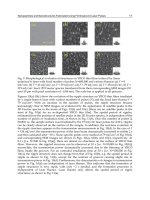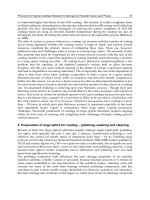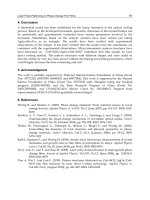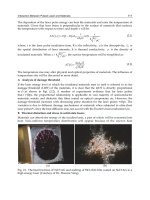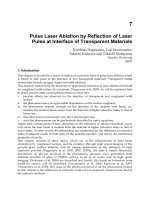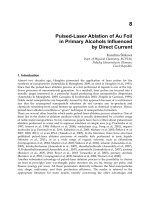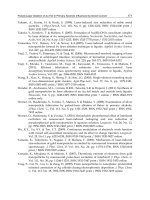Lasers Applications in Science and Industry Part 6 pptx
Bạn đang xem bản rút gọn của tài liệu. Xem và tải ngay bản đầy đủ của tài liệu tại đây (3.16 MB, 20 trang )
Laser Pulse Patterning on Phase Change Thin Films
91
4. Conclusion
A theoretical model has been established for the bump formation in the optical writing
process. Based on the developed formalism, geometric characters of the formed bumps can
be analytically and quantitatively evaluated from various parameters involved in the
formation. Simulations based on the analytic solution have been carried out taking
Ag
8
In
14
Sb
55
Te
23
as an example. The results have been verified with experimental
observations of the bumps. It has been verified that the results from the simulations are
consistent with the experimental observations. Micro/nanometric pattern structures have
been fabricated on
“ZnS–SiO2/AgOx/ZnS–SiO2” multilayer thin film sample by laser
direct writing method. The pattern structures with different shapes and sizes could be
directly written by very low laser power without developing and etching procedures, which
could largely decrease the time-consuming and cost.
5. Acknowledgment
The work is partially supported by National Natural Science Foundation of China (Grant
Nos. 50772120, 60507009, 60490290, and 60977004). This work is supported by the Natural
Science Foundation of China (Grant Nos. 50772120 and), Shanghai rising star tracking
program (10QH1402700), and the Basic Research Program of China (Grant No.
2007CB935400), and UNAM-DGAPA Mexico Grant No. IN120406-3. Support from
supercomputer DGSCA-UNAM is gratefully acknowledged.
6. References
Wuttig R. and Steimer C. (2007). Phase change materials: From material science to novel
storage devices. Applied Physics A, Vol.87, No.3, (June 2007), pp. 411-417, ISSN 1432-
0630
Kolobov A. V., Fons P., Frenkel A. I., Ankudinov A. L., Tominaga J., and Uruga T. (2004).
Understanding the phase-change mechanism of rewritable optical media. Nature
Materials, Vol.3, No.10, (October 2004), pp. 703-708, ISSN 1476-1122
Welnic W., Parnungkas A., Detemple R., Steimer C., Blugel S., and Wuttig M., (2006).
Unravelling the interplay of local structure and physical properties in phase-
change materials. Nature Materials, Vol.5, No.1, (January 2006), pp. 56-62, ISSN
1476-1122
Kalb J., Spaepen F., and Wuttig M. (2004). Atomic force microscopy measurements of crystal
nucleation and growth rates in thin films of amorphous Te alloys. Applied Physics
Letters, Vol.84, No.25, (June 2004), pp. 56-62, ISSN 0003-6951
Wei J., Jiao X., Gan F. and Xiao M. (2008). Laser pulse induced bumps in chalcogenide phase
change films. Journal of Applied Physics, Vol.103, No.12, (June 2008), pp. 124516-5,
ISSN 0021-8979
Dun A. Wei J. And Gan F. (2010). Pattern structures fabricated on ZnS–SiO2/AgOx/ZnS–
SiO2 thin film structure by laser direct writing technology. Applied Physics A,
Vol.100, No.2, (August 2010), pp. 401-407, ISSN 1432-0630
Lasers – Applications in Science and Industry
92
Shiu T., Grigoropoulos C. P., Cahill D. G., and Greif R. (1999). Mechanism of bump
formation on glass substrates during laser texturing. Journal of Applied Physics,
Vol.86, No.3, (August 1999), pp. 1311-6, ISSN 0021-8979
Tominaga J., Haratani S., Uchiyama K., and Takayama S. (1992). New Recordable Compact
Disc with Inorganic Material, AgOx. Japaness Journal of Applied Physics, Vol.31,
No.9A, (September 1992), pp. 2757-2759, ISSN 0021-4922
Liu W.C., Wen C.Y., Chen K.H., Lin W.C., and Tsai D.P. (2001). Near-field images of the
AgOx-type super-resolution near-field structure. Applied Physics Letters, Vol.78,
No.6, (February 2001), pp. 685-687, ISSN 0003-6951
5
Laser Patterning Utilizing Masked
Buffer Layer
Ori Stein and Micha Asscher
Institute of Chemistry and the Farkas Center for light
induced processes, The Hebrew University of Jerusalem
Israel
1. Introduction
Laser-matter interaction has been the focus of intense research over the past three decades
with diverse applications in the semiconductor industry (photolithography), sensing and
analytical chemistry in general. Pulsed laser ablation of adsorbates under well controlled
ultra high vacuum (UHV) conditions has enabled detection in the gas phase of large (mostly
biologically important) molecules via mass spectrometry, but also to study the remaining
species on the surface. In this chapter we will focus our report on these remaining atoms
and molecules following selective laser ablation of weakly bound buffer layers as a novel
tool for patterning of adsorbates on solid surfaces.
1.1 Patterning of adsorbates for diffusion measurements
Laser Induced Thermal Desorption (LITD) of adsorbates has developed as an important
technique for surface diffusion measurements. In the hole-refilling method, a hole was burnt
within an adsorbate covered surface. Subsequent time delayed laser pulse was employed to
measure the refilling rate due to surface diffusion process (Brand et al., 1988, Brown et al.,
1995). Accurate analysis of data acquired that way is not straight forward since the diffusion
measured this way is two dimensional (and not necessarily isotropic). The actual hole size
burnt into the surface is typically in the order of ~100µm, limiting the diffusion
measurement to relatively fast occurring processes with low energy barrier compared to the
activation energy for desorption.
A different method, utilizing two interfering laser beams to an adsorbate covered surface,
has resulted in a sinusoidal spatial temperature profile and selective desorption of the
adsorbates, thus creating a density modulation grating on the surface. In this way the typical
measured diffusion length can decrease down to sub-micrometer scale.
The grating formed on the surface obeys Bragg law:
2sin( )
w
(1)
w - grating period
λ - desorbing laser wave length
Lasers – Applications in Science and Industry
94
θ - angle between one of the incident laser beams and the surface normal.
Such grating formation can be explored optically by recording a diffraction pattern from
it. The decay of the measured 1
st
order diffraction due to smearing of the grating
formation is indicative of one dimensional diffusion process- at the direction normal to
the grating stripes. In this way, anisotropic diffusion can be measured simply by changing
the direction of the substrate with respect to the grating symmetry. Second Harmonic
Generation (SHG) diffraction from one monolayer (1ML) of CO on Ni(111), (Zhu et al.
1988, 1989) and on Ni(110), (Xiao et al. 1991). Coverage dependent diffusion coefficient
models were found necessary to understand the experimental data (see e.g. Rosenzwig et
al, 1993, Verhoef and Asscher, 1997, Danziger et al. 2004). An alternative way, utilizing
optical linear diffraction method combined with polarization modulation techniques (Zhu
et al. 1991, Xiao et al, 1992, Wong et al. 1995, Fei and Zhu, 2006) has yielded a more
sensitive and accurate calculation of the anisotropic diffusion coefficient of CO on Ni(110),
(Xiao et al, 1993).
Selective patterning of H on top of Si(111) surface (Williams et al. 1997) was demonstrated
via pre-patterning a thin layer of Xe adsorbed on the Si surface that has reduced the sticking
coefficient of H on Si by more than an order of magnitude. This way the authors were able
to pattern chemisorbed H while avoiding high power laser pulses impinging on the surface
thus preventing possible laser induced surface damage.
We have recently introduced a procedure that adopts the concept of laser-induced ejection
of a weakly bound, volatile layer, applied for generation of size-controlled arrays of
metallic clusters and sub- micron wide metallic wires. This buffer layer assisted laser
patterning (BLALP) procedure utilizes a weakly bound layer of frozen inert gas atoms
(e.g., Xe) or volatile molecules (e.g., CO
2
and H
2
O) that are subsequently exposed to metal
atoms evaporated from a hot source. It results in the condensation of a thin metal layer
(high evaporation flux) or small clusters (low flux) on the top surface of the buffer layer.
The multi-layered system is then irradiated by a short single laser pulse (nsec duration)
splits and recombines on the surface in order to form the interference pattern. It results in
selective ablation of stripes of the volatile buffer layer along with the metallic adlayer
deposited on it. This step is followed by a slow thermal annealing to evaporate the
remaining atoms of the buffer layer with simultaneous soft landing of metallic stripes on
the substrate. In other words, this procedure combines the method for generating grating-
like surface patterns by laser interference (Zhu et al. 1988, Williams et al. 1997) with a
buffer-assisted scheme for the growth of metallic clusters (Weaver and Waddill, 1991,
Antonov et al., 2004).
Employing a single, low power laser pulse, the BLALP technique has been utilized to form
parallel stripes of potassium (Kerner and Asscher, 2004a, Kerner et al., 2006), as well as
continuous gold wires (Kerner and Asscher, 2004b) strongly bound to a ruthenium single
crystal substrate.
An extensive study of surface diffusion of gold nanoclusters on top of Ru(100) and p(1x2)-
O/Ru(100) was preformed utilizing the BLALP technique (Kerner et al., 2005). The
authors discuss the smearing out of gold clusters density grating deposited on the
substrate due to one dimensional diffusion process. Figure 1 describes the smearing out of
a density grating created after evaporating 1nm of gold onto 60ML of Xe adsorbed on
Ru(100) surface.
Laser Patterning Utilizing Masked Buffer Layer
95
Heating a similar grating structure in air to 600K for 2h has resulted in no noticeable effect
on the metal clusters forming the grating. It is believed that heavy oxidation of the Ru
substrate under these conditions acts as an anchor and inhibited the cluster diffusion.
Smearing out of the density grating had little or no effect on the size distribution of the gold
clusters, suggesting no significant sintering and coalescence of the clusters under these
conditions.
Fig. 1. AFM images of a high density gold cluster coverage grating created via BLALP
scheme, evaporating 1nm of gold on top of 60ML of Xe. All images were taken at ambient
environment. A) After annealing in vacuum to 300K and kept at room temperature. B) After
annealing to 450K at 3K/s and quenched back to room temperature. Images are courtesy of
Kerner et al., 2005.
Monitoring clusters' diffusion in-situ is possible by simultaneously recording the first order
linear diffraction signal decay resulting from shining low power (5mW) He-Ne cw laser on
such grating while heating the substrate. The 1
st
order diffraction decay can be correlated to
the diffusion coefficient of the clusters on the substrate (Zhu et al., 1991, Zhu, 1992). Due to
the large temperature range in which diffusion takes place in this system (~250K),
performing isothermal measurements is impractical. Introducing a novel, non-isothermal
diffusion method has enabled Kerner et al. to circumvent the complexity of isothermal
diffusion measurements in this system and has provided the authors a method to measure
the diffusion of a range of cluster sizes and density distributions on top of Ru(100) and on
top of p(1x2)-O/Ru(100). On both surfaces, it was found that the diffusion coefficient is
density (coverage) independent. The activation energy for diffusion was sensitive to the
cluster size on the bare Ru(100) surface but only weakly dependent on cluster size on the
p(1x2)-O/Ru(100) surface. This arises from the weak interaction of the gold clusters with the
oxidized surface and in particular the incommensurability of the clusters with the under
laying oxidized substrate.
Lasers – Applications in Science and Industry
96
1.2 Pulsed laser driven lithography and patterning
Direct laser interference lithography/patterning involving selective removal of material
from the surface of a solid sample employing two or more interfering laser beams has been
used in a large variety of applications. These techniques were utilized for polymers
patterning, micromachining, semiconductor processing, oxide structure formation and for
nano-materials control over magnetic properties(Kelly et al., 1998, Ihlemqnn & Rubahn,
2000, Shishido et al., 2001, Chakraborty et al., 2007, Lasagni et al., 2007, 2008, Leiderer et al.,
2009, Plech et al., 2009).
A modified version of the BLALP technique that involves laser patterning of the clean
volatile buffer layer prior to the deposition of the metal layer has also been introduced to
generate smooth metallic stripes on metallic (Kerner et al., 2004c, 2006) as well as oxide
(SiO
2
/Si(100)) substrates. The unique advantage of BLALP is the low laser power needed for
patterning, which prevents any damage to the substrate.
The importance of laser-driven ejection of a layer of weakly bound material from light
absorbing substrates has motivated a number of experimental (Kudryashov & Allen 2003,
2006, Lang & Leiderer, 2006, Frank et al.,2010) and computational studies (Dou et al., 2001a,
2001b, Dou et al., 2003, Smith et al., 2003, Gu & Urbassek, 2005, 2007, Samokhin, 2006)
targeted at revealing the fundamental mechanisms responsible for the layer ejection. The
physical picture emerging from these investigations suggests that fast vaporization
(explosive boiling) and expansion of the superheated part of the layer adjacent to the hot
substrate provides the driving force for the ejection of the remaining part of the layer.
In this paper, we report the results of utilizing a single pulse laser patterning, all-in vacuum
procedure that can produce practically any sub- micron resolution pattern using an optical
system consisting of a masked imaging system.
2. Experimental
The experimental setup has been described elsewhere in detail (Kerner et al., 2005a,
2005b). Briefly, a standard UHV chamber at a base pressure of 5x10
-10
mbar, equipped with
Ne
+
sputter gun for sample cleaning and a quadrupole mass spectrometer (QMS, VG SX-
200) for exposure and coverage determination and calibration, are used in the
experiments. In addition, separate Au, Ag and Ti deposition sources are used, with in-situ
quartz microbalance detector for flux calibration measurements. A native oxide
SiO
2
/Si(100) sample is attached via copper rods to a closed cycle helium cryostat (APD)
that cools the sample down to 25 K with heating capability up to 800 K (Stein & Asscher,
2006). 700eV Ne
+
ion sputtering for sample cleaning was carried out prior to each
patterning experiment.
In order to perform laser assisted ablation and patterning measurements, a p-polarized
Nd:YAG pulsed laser working at the second harmonic wavelength was used (Surlight,
Continuum λ = 532 nm, 5 ns pulse duration). The laser power absorbed by the silicon
substrate was kept lower than 80 MW/cm
2
(160mJ/pulse) to avoid surface damage (Koehler
et al., 1988). During the experiments we assumed complete thermalization between the
SiO
2
/Si layers with no influence of the thin oxide layer (~2.5 nm thick) on the heat flow
towards the adsorbates. Details of Xe template formation via laser induced thermal
desorption (LITD) and its characterization are given elsewhere (Kerner & Asscher 2004a,
2004b, Kerner et al., 2005, 2006). After patterning the physisorbed Xe, 12±1 nm thick film
Laser Patterning Utilizing Masked Buffer Layer
97
of metal, typically Au or Ag, is deposited on the entire sample. Subsequently, a second
uniform laser pulse strikes the surface, ablating the stripes of Xe buffer layer remaining on
the substrate together with the deposited metal film/clusters on top and leaving behind
the strongly bound metal stripes that are in direct contact with the SiO
2
surface. A 2±1 nm
thick layer of Ti deposited over the SiO
2
surface prior to the buffer layer adsorption and
metal grating formation, ensures good adhesion of the noble metals to the silicon oxide
substrate and avoid de-wetting (Bauer et al., 1980, George et al., 1990, Camacho-López et
al., 2008). The Ti adhesion layer does not affect the optical properties of the substrate
(Bentini et al., 1981).
Patterning through a mask is introduced here for the first time, utilizing a single uniform
laser pulse. The mask is a stainless steel foil 13µm thick that contains the laser engraved
word "HUJI" (Hebrew University Jerusalem Israel). An imaging lens was used in order to
transfer the object engraved on the mask onto the sample plane while reducing its size
according to the lens formula:
111
uv
f
(2)
u
- mask-lens distance (120 cm).
v- lens- sample distance (24 cm).
f- focal length of the lens (20 cm) .
Ex-situ characterization of the resulting patterns was performed by HR-SEM (Sirion, FEI),
AFM in tapping mode (Nanoscope Dimension 3100, Veeco) and an optical microscope
(Olympus BX5).
3. Results and discussion
3.1 Metallic line patterning via laser interference
Metallic lines were patterned directly on the SiO
2
/Si sample using Lift-off
(Kerner et al.,
2004c, 2006) and BLALP schemes. Using CO
2
as the buffer material it was possible to
perform a BLALP patterning process under less stringent cooling requirements than those
previously used with Xe as the buffer material (Rasmussen et al. 1992, Funk et al., 2006).
Figure 2 demonstrates the results of patterning 12 nm thick layer of Au using 10ML of CO
2
as the buffer material.
Although metal stripes obtained this way demonstrate good continuity, their texture is
corrugated since these stripes are composed of metal clusters soft-landed on the substrate
after annealing the sample to room temperature, according to buffer layer assisted growth
(BLAG) procedure
(Weaver & Waddill 1991). Using this scheme, metal clusters are evenly
distributed in the areas between the metal stripes. Molecular dynamics (MD) simulations
describing the laser ablation of the buffer material from a silicon surface have indicated that
under the experimental conditions adopted in the current study, evaporative buffer material
removal scheme is dominant (Stein et al., 2011). This evaporative mode of ablation, unlike
the abrupt or explosive ablation that dominates at higher laser power, does not necessarily
removes all the metal layer or clusters that reside on top. In this case, therefore it is likely
that some of the metal evaporated on top of the buffer could not be removed by the laser
pulse, and was finally deposited on the surface as clusters.
Lasers – Applications in Science and Industry
98
Fig. 2. AFM image of BLALP patterning of 12 nm thick layer of Au deposited on top of
10ML CO
2
buffer material on a SiO
2
/Si(100) sample at 25 K. Laser power was 14 MW/cm
2
.
Figure 3 illustrates the two different Xe removal mechanisms. Figures 3A and 3B
demonstrate intense evaporation and explosive desorption of Xe from Si(100) surface,
respectively (Stein et al., 2011).
Figure 4 demonstrates lift-off patterning: after patterning 80ML of Xe using laser power of
12MW/cm
2
, 18 nm of Au were deposited on the sample. A second, uniform pulse at a
power of 9MW/cm
2
was subsequently applied in order to remove the remaining Xe and
metal on top.
The fragmented and discontinuous nature of the metal stripes resulting from this
patterning procedure on SiO
2
/Si samples is apparent. This shape is due to the poor
adhesion (and de-wetting) of Au on SiO
2
(Bentini et al., 1981, George et al., 1990, Lani et
al., 2006). Overcoming this problem requires evaporation of 2±1 nm Ti on top of the entire
SiO
2
surface as an adhesion and wetting layer (Bentini et al., 1981). Figure 5 displays the
effect of Ti evaporation on the integrity and smoothness of the metal stripes patterned via
the lift off procedure.
The images in figure 5 reveal a clear power effect which is a characteristic feature of the lift-
off patterning scheme. Raising the laser power leads to widening of the ablated buffer
troughs as the sinusoidal temperature profile increases. Into these wider troughs metal is
Laser Patterning Utilizing Masked Buffer Layer
99
evaporated, eventually (after the second pulse) forming smooth and continuous wires,
ideally across the entire laser beam size. Increasing the pulse power by 40% has led to wider
stripes from 700 nm to 1300 nm, see Fig. 5A and 5B.
Fig. 3. Snapshots from MD simulations performed on 7744 Xe atoms adsorbed on top of
Si(100) surface. A and B represent evaporative and explosive desorption while irradiating
the surface by 12 and 16MW/cm
2
pulse power, respectively. Snapshots were taken at 9.4 ns
(A) and 6.6 ns (B) from the onset of the laser pulse.
Electrical resistance measurements were performed on these metallic wires. On a patterned
sample a set of 100X100µm metallic pods with ohmic contact to the patterned wires were
prepared by e-bean lithography in order to ex-situ measure the resistivity of the silver metal
wires. The resistivity measurements were calibrated against a similar measurement performed
using Au wires of identical dimensions, produced via e-beam lithography.Measurements have
revealed that the resistivity of the laser patterned wires were about 40% (on average,
calculated from four different measurements performed at different locations on the sample)
higher compared to the e-beam prepared Au, 197 and 140Ω for the laser-patterned Ag and the
e-beam Au over a line distance of 24.2µm, respectively. Annealing the patterned sample at
600K for two hours in ambient conditions has led to higher resistivity by 60%, as a result of
oxidation and aggregation of the Ag wires, increasing from 197 to 318Ω. In contrast, the
annealed Au wires have shown a 75% drop in resistivity, from 140 to 79Ω, as expected since no
oxidation takes place in the case of gold. Figure 6 demonstrates the aggregation occurs within
the Ag stripes to form spherical clusters caused by annealing the sample to 600K for two hours
in ambient conditions.
Lasers – Applications in Science and Industry
100
Fig. 4. SEM image of lift- off patterning of 18 nm Au on top of SiO
2
/Si surface. The power of
the first and second laser pulses was 12 and 9MW/cm
2
, respectively. Inset depicts the
corrugated (and fragmented) texture of the resulting metal wires.
Fig. 5. AFM images of lift-off patterning procedure including line scan along the red line. A) 15
nm of Ag on top of a coverage grating formed via a 50ML Xe on Ti/SiO
2
/Si surface. First and
second pulse power were both of 10 MW/cm
2
. B) 12 nm of Ag on top of grating produced with
70ML Xe on top of Ti/SiO
2
/Si surface. Both the first and second pulses were at 14 MW/cm
2
.
Laser Patterning Utilizing Masked Buffer Layer
101
Fig. 6. Annealing effect on a lift-off patterned sample consisting of 20 nm of Ag evaporated
on 70ML of Xe grating on Ti/SiO
2
/Si surface. A and B: AFM images in ambient conditions
before and after annealing to 600K, respectively.
3.2 Laser patterned mask imaging
General application of the buffer layer assisted laser patterning scheme requires the ability
to perform any desired shape and structure. This can be achieved by striking the buffer
covered substrate with a laser beam that has been partially blocked by a patterned mask. In
order to demonstrate the ability to pattern via a mask, a stainless steel foil, 12.7µm thick that
contains the laser engraved word "HUJI" as our mask, the size of the word-object was
4X1.3mm. After passing through the mask, the laser pulse traveled through a lens in order
to reduce-image the HUJI word on the sample's plane. Five times reduction required a 20
cm focal length lens at a distance of 120 and 24 cm from the mask and sample, respectively.
Using this imaging lens required a dramatic reduction of laser power in order to avoid
surface damage. Figure 7 demonstrates the lift-off lithography of the word "HUJI" on top of
Ti/SiO
2
/Si surface.
A 60 ML Xe deposited on Ti/SiO
2
/Si(100) sample was prepared to demonstrate the mask-
laser patterning. A single pulse, 0.8 MW/cm
2
(2.5 mJ/pulse) penetrating through the mask
and the lens system was employed as described above. Prior to the second, uniform laser
pulse striking the entire sample without the mask and the lens, 12±2 nm Au was evaporated
on top of the HUJI patterned Xe buffer layer covered substrate. The sample was
subsequently heated to room temperature and removed from the vacuum chamber for
characterization using AFM and optical microscopy.
Employing a weaker first laser pulse at a power of 0.5 MW/cm
2
(1.5 mJ/pulse) prior to the
evaporation of gold, has resulted in a narrower line width of the final pattern although with
somewhat poorer quality (not shown), as was previously demonstrated in the case of two
interfering beams forming parallel metallic stripes (see Fig. 5 above). This behavior, of
Lasers – Applications in Science and Industry
102
Fig. 7. A) Optical microscope image of the word "HUJI" following lift-off lithography
written by 12±2 nm thick Au on Ti/SiO
2
/Si surface. First pulse 0.8 MW/cm
2
, Xe buffer
thickness was 60ML. B) AFM image demonstrating the edge of the patterned letter "H". C) A
height profile taken along the line in image B.
narrowing the line width of a given feature while lowering the pulse power is a result of the
laser pulse Gaussian spatial profile. As the first pulse power goes up, a wider part of the
pulse reaches ablation threshold of the buffer material (Xe in this case), allowing more buffer
material to be removed from the surface. Line narrowing through pulse power lowering is
one of the characteristics of the lift-off patterning scheme. This power knob is a unique, very
practical and easy to use for various applications, allowing patterning far from substrate
laser induced damage threshold. One should bear in mind that the total pattern quality is
highly dependent on the first pulse power uniformity as random variations in the laser
pulse profile will be manifested in overall lower quality pattern, especially while employing
near ablation threshold power.
By tuning the first pulse power up from 0.5 MW/cm
2
( 1.5 mJ/pulse) to 0.8 MW/cm
2
(Fig.
7A) we were able to significantly improve the image quality while introducing a minor
increase in the size of the object, all without changing the optical imaging parameters.
Laser Patterning Utilizing Masked Buffer Layer
103
Image 7B represents a characteristic edge image of the patterned object, utilizing a tapping
mode AFM. One can clearly notice the corrugated texture of the evaporated gold film on top
of the Ti/SiO
2
/Si surface, featuring the 3D growth of multilayer Au on top of metal
surfaces. Looking at the line profile presented in fig. 7C, the sharp drop representing the
edge of the letter "H", as shown in the image. The sharp drop from the top of the gold film
to the bottom of the Ti surface occurs in a lateral distance of ~50 nm, ten times smaller
than the 532 nm wavelength used in this experiment, evidence to the abrupt, temperature
exponential dependent ablation of the Xe buffer. Even in our simple, basic optical design
consisting of a mask and lens, we were able to arrive at the sharply resolved lines shown
in Fig. 7A. Simple reduction in the ablating laser wavelength and by meticulously
measure the relevant distances (objective- lens, lens- surface) one can further enhance this
process' resolution.
This simple, all-in-vacuum fast and clean patterning procedure does require highly accurate
and robust, through vacuum imaging technique in order to avoid standard diffraction based
distortions of the desired features to be patterned.
4. Conclusions
The role of weakly bound atomic and molecular buffer layers in forming periodic coverage
density has been discussed as a versatile tool to study in-vacuum metallic nano-particles
growth and their surface diffusivity, an important aspect of catalysis. In addition, we have
demonstrated the application of the buffer layer method to pattern a Ti/SiO
2
/Si surface
using pulsed laser lithography through a simple optical system consisting of a mask and an
imaging lens. Feature (the letters HUJI) size reduction of 1:5 has been demonstrated with
AFM imaged sharp edges that are three orders of magnitude narrower than a letter size.
Focusing on weakly bound buffer materials for the patterning method has enabled us to use
low power laser, significantly below surface damage threshold. Employing the buffer
assisted laser patterning method there is virtually no limit to the pattern that can be
transferred to practically any (light absorbing) substrate.
5. Acknowledgments
Partial support for this research by the US-Israel Binational Science Foundation and the
Israel Science Foundation is acknowledged. The authors thank Uriel Levi for insightful
discussions and help regarding in-vacuum imaging.
6. References
Antonov, V. N., J. S. Palmer, P. S. Waggoner, A. S. Bhatti, and J. H. Weaver. (2004).
Nanoparticle diffusion on desorbing solids: The role of elementary excitations in
buffer-layer-assisted growth. Physical Review B 70 (4) ISSN: 1098-0121.
Bauer, R. S., R. Z. Bachrach, and L. J. Brillson. (1980). Au and Al interface reactions with
SiO
2
. Applied Physics Letters 37 (11):1006-1008 ISSN: 0003-6951.
Bentini, G. G., C. Cohen, A. Desalvo, and A. V. Drigo. (1981). Laser annealing of damaged
silicon covered with a metal-film - test for epitaxial-growth from the melt. Physical
Review Letters 46 (2):156-159 ISSN: 0031-9007.
Lasers – Applications in Science and Industry
104
Brand, J. L., A. A. Deckert, and S. M. George. (1988). Surface-diffusion of hydrogen on
sulfur-covered Ru(001) surfaces studied using laser-induced thermal-desorption.
Surface Science 194 (3):457-474 ISSN: 0039-6028.
Brown, D. E., D. S. Sholl, R. T. Skodje, and S. M. George. (1995). Surface-diffusion of H and
Co on Cu/Ru(001) - evidence for long-range trapping by copper islands. Chemical
Physics 201 (1):273-286 ISSN: 0301-0104.
Camacho-Lopez, S., R. Evans, L. Escobar-Alarcon, and M. A. Camacho-Lopez. (2008).
Polarization-dependent single-beam laser-induced grating-like effects on titanium
films. Applied Surface Science 255 (5):3028-3032 ISSN: 0169-4332.
Chakraborty, S., H. Sakata, E. Yokoyama, M. Wakaki, and D. Chakravorty. (2007). Laser-
induced forward transfer technique for maskless patterning of amorphous V2O5
thin film. Applied Surface Science 254:638-643 ISSN: 0169-4332.
Danziger, I. M., B. Hallac, and M. Asscher. (2004). Surface diffusion of potassium
coadsorbed with CO on Ru(001): A coverage grating-optical second harmonic
diffraction study. Journal of Physical Chemistry B 108 (46):17851-17856 ISSN: 1520-
6106.
Dou, Y. S., N. Winograd, B. J. Garrison, and L. V. Zhigilei. (2003). Substrate-assisted laser-
initiated ejection of proteins embedded in water films. Journal of Physical Chemistry
B 107 (10):2362-2365 ISSN: 1089-5639.
Dou, Y. S., L. V. Zhigilei, Z. Postawa, N. Winograd, and B. J. Garrison. (2001). Thickness
effects of water overlayer on its explosive evaporation at heated metal surfaces.
Nuclear Instruments & Methods in Physics Research Section B-Beam Interactions with
Materials and Atoms 180:105-111 ISSN: 1520-6106.
Dou, Y. S., L. V. Zhigilei, N. Winograd, and B. J. Garrison. (2001). Explosive boiling of water
films adjacent to heated surfaces: A microscopic description. Journal of Physical
Chemistry A 105 (12):2748-2755 ISSN: 0295-5075.
Fei, Y. Y., and X. D. Zhu. (2006). Surface diffusion of hydrogen atoms on Cu(111) studied by
optical diffraction from hydrogen density patterns formed on removable templates
of xenon monolayers. Europhysics Letters 76 (5):877-883 ISSN: 0295-5075.
Frank, P., J. Graf, F. Lang, J. Boneberg, and P. Leiderer. (2010). Laser-induced film ejection at
interfaces: Comparison of the dynamics of liquid and solid films. Applied Physics a-
Materials Science & Processing 101 (1):7-11DOI 10.1007/s00339-010-5770-5 ISSN:
0947-8396.
Funk, S., B. Hokkanen, J. Wang, U. Burghaus, G. Bozzolo, and J. E. Garces. (2006).
Adsorption dynamics of CO2 on Cu(110): A molecular beam study. Surface Science
600 (3):583-590 ISSN: 0039-6028.
George, M. A., Q. C. Bao, I. W. Sorensen, W. S. Glaunsinger, and T. Thundat. (1990).
Thermally induced changes in the resistance, microstructure, and adhesion of thin
gold-films on Si SiO
2
substrates. Journal of Vacuum Science & Technology a-Vacuum
Surfaces and Films 8 (3):1491-1497 ISSN: 0734-2101.
Gu, X., and H. M. Urbassek. (2005). Atomic dynamics of explosive boiling of liquid-argon
films. Applied Physics B-Lasers and Optics 81 (5):675-679 ISSN: 0946-2171.
Gu, X., and H. M. Urbassek. (2007). Laser-induced desorption of overlayer films off a heated
metal substrate. Applied Surface Science 253 (9):4142-4149 ISSN: 0169-4332.
Ihlemann, J., and K. Rubahn. (2000). Excimer laser micro machining: fabrication and
applications of dielectric masks. Applied Surface Science 154:587-592 ISSN: 0169-4332.
Laser Patterning Utilizing Masked Buffer Layer
105
Kelly, M. K., J. Rogg, C. E. Nebel, M. Stutzmann, and S. Katai. 1998. High-resolution thermal
processing of semiconductors using pulsed-laser interference patterning. Physica
Status Solidi a-Applied Research 166 (2):651-657 ISSN: 0031-8965.
Kerner, G., and M. Asscher. (2004). Laser patterning of metallic films via buffer layer. Surface
Science 557 (1-3):5-12 ISSN: 0039-6028.
Kerner, G., and M. Asscher. (2004). Buffer layer assisted laser patterning of metals on
surfaces. Nano Letters 4 (8):1433-1437 ISSN: 1530-6984.
Kerner, G., O. Stein, M. Asscher. (2004). "Physisorbed buffer layer as a template for pulsed
laser patterning of metallic thin films: an alternative approach for
photolithography", Proc. SPIE, vol. 5531, pp. 128-136 DOI: 10.1117/12.557621.
Kerner, G., Y. Horowitz, and M. Asscher. (2005). Diffusion of buffer layer assisted grown
gold nanoclusters on Ru(100) and p(1 x 2)-O/Ru(100) surfaces. Journal of Physical
Chemistry B 109 (10):4545-4553 ISSN: 1520-6106.
Kerner, G., O. Stein, and M. Asscher. (2006). Patterning thin metallic film via laser structured
weakly bound template. Surface Science 600 (10):2091-2095 ISSN: 0039-6028.
Kerner, G., O. Stein, Y. Lilach, and M. Asscher. (2005). Sublimative desorption of xenon from
Ru(100). Physical Review B 71 (20) ISSN: 1098-0121.
Koehler, B. G., C. H. Mak, D. A. Arthur, P. A. Coon, and S. M. George. (1988). Desorption-
kinetics of hydrogen and deuterium from Si(111) 7x7 studied using laser-induced
thermal-desorption. Journal of Chemical Physics 89 (3):1709-1718 ISSN: 0021-9606.
Kudryashov, S. I., and S. D. Allen. (2003). Optical transmission measurements of explosive
boiling and liftoff of a layer of micron-scale water droplets from a KrF laser-heated
Si substrate. Journal of Applied Physics 93 (7):4306-4308 ISSN: 0021-8979.
Kudryashov, S. I., K. Lyon, and S. D. Allen. (2006). Near-field thermal radiative transfer and
thermoacoustic effects from vapor plumes produced by pulsed CO2 laser ablation
of bulk water. Journal of Applied Physics 100 (12) ISSN: 0021-8979.
Lang, F., and P. Leiderer. (2006). Liquid-vapour phase transitions at interfaces: sub-
nanosecond investigations by monitoring the ejection of thin liquid films. New
Journal of Physics 8, 14 ISSN: 1367-2630.
Lani, S., A. Bosseboeuf, B. Belier, C. Clerc, C. Gousset, and J. Aubert. (2006). Gold
metallizations for eutectic bonding of silicon wafers. Microsystem Technologies-
Micro-and Nanosystems-Information Storage and Processing Systems 12 (10-11):1021-
1025 ISSN: 0946-7076.
Leufke, P. M., S. Riedel, M. S. Lee, J. Li, H. Rohrmann, T. Eimuller, P. Leiderer, J. Boneberg,
G. Schatz, and M. Albrecht. (2009). Two different coercivity lattices in Co/Pd
multilayers generated by single-pulse direct laser interference lithography. Journal
of Applied Physics 105 (11) ISSN: 0021-8979.
Plech, A., P. Leiderer, and J. Boneberg. (2009). Femtosecond laser near field ablation. Laser &
Photonics Reviews 3 (5):435-451 ISSN: 1863-8880.
Rasmussen, P. B., P. A. Taylor, and I. Chorkendorff. (1992). The interaction of carbon-
dioxide with Cu(100). Surface Science 270:352-359 ISSN: 0039-6028.
Rosenzweig, Z., I. Farbman, and M. Asscher. (1993). Diffusion of ammonia on Re(001) - a
monolayer grating optical 2nd-harmonic diffraction study. Journal of Chemical
Physics 98 (10):8277-8283 ISSN: 0021-9606.
Lasers – Applications in Science and Industry
106
Samokhin, A. A. (2006). Estimate of pressure produced during explosive boiling of a liquid
film on a substrate heated by laser pulses. Quantum Electronics 36 (7):684-686 ISSN:
1063-7818.
Shishido, A., I. B. Diviliansky, I. C. Khoo, T. S. Mayer, S. Nishimura, G. L. Egan, and T. E.
Mallouk. (2001). Direct fabrication of two-dimensional titania arrays using
interference photolithography. Applied Physics Letters 79 (20):3332-3334 ISSN: 0003-
6951.
Smith, K. M., M. Y. Hussaini, L. D. Gelb, and S. D. Allen. (2003). Modeling laser-assisted
particle removal using molecular dynamics. Applied Physics a-Materials Science &
Processing 77 (7):877-882 ISSN: 0947-8396.
Stein, O., and M. Asscher. (2008). Adsorption of H2O, CO2 and Xe on soft surfaces. Journal of
Physical Chemistry B 112 (13):3955-3962 ISSN: 1520-6106.
Stein O., Z. Lin, L.V. Zhigilei, M, Asscher, (2011)"Selective ablation of Xe from Silicon
surfaces: MD simulations and experimental laser patterning", Journal of Physical
Chemistry A., Accepted .
Verhoef, R. W., and M. Asscher. (1997). Effect of lateral interactions on coverage grating
formation on surfaces. Surface Science 376 (1-3):389-394 ISSN: 0039-6028.
Weaver, J. H., and G. D. Waddill. (1991). Cluster assembly of interfaces - nanoscale
engineering. Science 251 (5000):1444-1451 ISSN: 0036-8075.
Williams, P. A., G. A. Reider, L. P. Li, U. Hofer, T. Suzuki, and T. F. Heinz. 1997.
Physisorbed template for spatial patterning of adsorbates. Physical Review Letters 79
(18):3459-3462 ISSN: 0031-9007.
Wong, A., A. Lee, and X. D. Zhu. (1995). Coverage dependence of quantum tunneling
diffusion of hydrogen and deuterium on Ni(111). Physical Review B 51 (7):4418-4425
ISSN: 0163-1829.
Xiao, X. D., Y. L. Xie, and Y. R. Shen. (1992). Surface-diffusion probed by linear optical
diffraction. Surface Science 271 (1-2):295-298 ISSN: 0039-6028
Xiao, X. D., Y. L. Xie, and Y. R. Shen. (1993). Coverage dependence of anisotropic surface-
diffusion - CO/Ni(110). Physical Review B 48 (23):17452-17462 ISSN: 1098-0121.
Xiao, X. D., X. D. Zhu, W. Daum, and Y. R. Shen. (1991). Anisotropic surface-diffusion of CO
on Ni(110). Physical Review Letters 66 (18):2352-2355 ISSN: 0031-9007.
Zhu X. D. (1992). Optical Diffractions as Probes to Surface Diffusion of Adsorbates. Modern
Physics Letters B, 6 (20) 1217-1235.
Zhu X. D., A. Lee & A. Wang, (1991). Detection of Monolayer Gratings of Adsorbates by
Linear Optical Diffraction. Applied Physics A. 52. 317-322, PACS: 78.65-s, 07.60. Hv,
68.35. Fx
Zhu, X. D., T. Rasing, and Y. R. Shen. (1988). Surface-diffusion of CO on Ni(111) studied by
diffraction of optical second-harmonic generation off a monolayer grating. Physical
Review Letters 61 (25):2883-2885 ISSN: 0031-9007.
Zhu, X. D., and Y. R. Shen. (1989). Generation and detection of a monolayer grating by laser
desorption and 2nd-harmonic generation - CO on Ni(111). Optics Letters 14 (10):503-
505 ISSN: 0146-9592.
Part 2
Laser-Matter Interaction
6
Interaction Between Pulsed Laser and Materials
Jinghua Han
1
and Yaguo Li
2,3
1
College of Electronics & Information Engineering,
Sichuan University, Chengdu,
2
Fine Optical Engineering Research Center, Chengdu,
3
Department of Machine Intelligence & Systems Engineering,
Akita Prefectural University, Yurihonjo,
1,2
China
3
Japan
1. Introduction
The research on laser-matter interaction can bridge the gap between practical problems and
applications of lasers, which offers an important way to study material properties and to
understand intrinsic microstructure of materials. The laser irradiation-induced effects on
materials refer to numerous aspects, including optical, electromagnetic, thermodynamic,
biological changes in material properties. The laser-matter interaction is an interdisciplinary
and complicated subject
[1]
. When the material is irradiated with lasers, the laser energy will
be firstly transformed into electronic excitation energy and then transferred to lattices of
materials through collisions between electrons and lattices. The deposition of laser energy
will produce a series of effects, such as temperature rise, gasification and ionization. The
physical processes of interactions between lasers and matters can be grouped into linear and
nonlinear responses of materials to laser pulses, namely thermal effects, nonlinear
interactions, laser plasma effects and so forth
[2,3]
. This chapter aims at analyzing the above-
mentioned major effects due to laser irradiation.
2. Thermodynamics
Laser ablation entails complex thermal processes influenced by different laser parameters,
inclusive of laser pulse energy, laser wavelength, power density, pulse duration, etc (Fig. 1).
According to the response of material to incident laser, the responses can be categorized into
two groups: thermal and mechanical effects. Thermal effects refer to melting, vaporization
(sublimation), boiling, and phase explosion while mechanical response involves
deformation and resultant stress in materials. Different thermal processes will induce
different mechanical responses, which will be detailed in the following.
2.1 Thermal effects
Materials subjected to laser irradiation will absorb the incident laser energy, raising the
temperature and causing material expansion and thermal stress in materials. When the
stress exceeds a certain value, the material may fracture and/or deform plastically. Material
expansion will induce various changes in refractive index, heat capacity, etc.
Lasers – Applications in Science and Industry
110
Fig. 1. Laser-matter interactions involve numerous complicated processes, inclusive of
physical, mechanical, thermal, optical effects, etc. A full understanding of laser-matter
interactions continues to be elusive.

